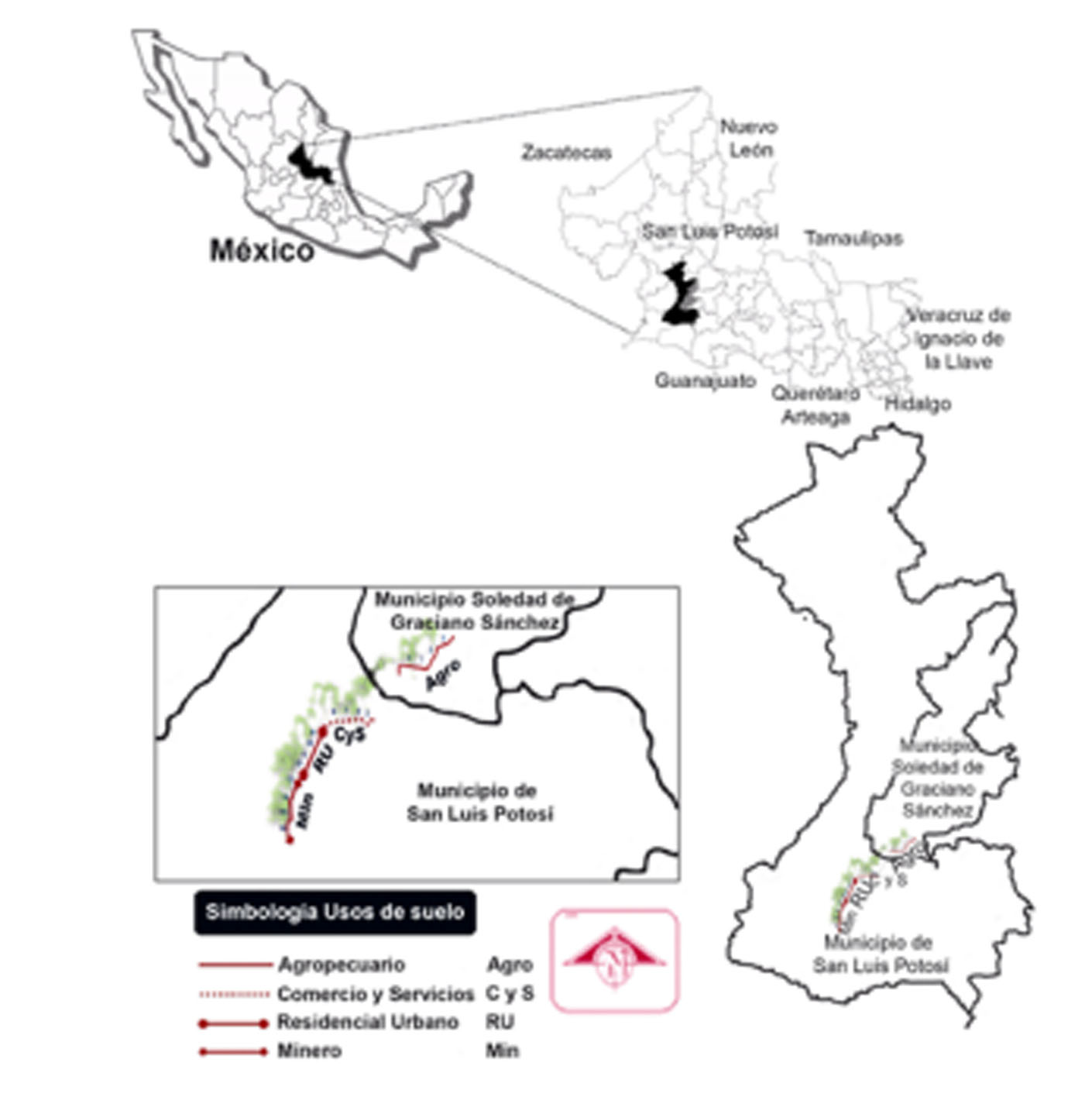Vegetación bioindicadora de metales pesados en un sistema semiárido
Palabras clave:
contaminación, uso de suelo, hojas, estación, impacto ambientalResumen
 Evaluar la contaminación por metales pesados en los ecosistemas permite conocer la capacidad bioindicativa de especies vegetativas. El objetivo fue determinar la concentración de metales pesados en Prosopis laevigata, Acacia spp. y Schinus molle bajo el efecto de usos suelo y temporalidad. El área se sitúa en la colindancia de los Municipios de Soledad de Graciano Sánchez y San Luis Potosí fragmentada por usos de suelo: agropecuario, comercio y servicios, residencial urbano y minero. Fueron tomadas muestras de hojas de las tres especies en las estaciones de verano, otoño, invierno y primavera y se evaluó la concentración de metales pesados a través de la técnica de ICP-MS. Los análisis estadísticos indicaron niveles de Aluminio (Al) > Cinc (Zn) > Plomo (Pb) > Cobre (Cu) > Titanio (Ti) > Vanadio (V) > Arsénico (As) > Cromo (Cr) > Cadmio (Cd) > Cobalto (Co). Los elementos Al, As, Cd, Cr, Pb y Ti presentaron niveles por encima del umbral normal en vegetación. El uso de suelo tuvo efecto significativo con Al, Ti, Cd, As y Pb; los árboles ubicados en los usos de suelo minero, comercio y servicios tuvieron la mayor concentración. La especie tuvo efecto significativo con Al y Pb siendo Acacia spp. el que presentó la mayor capacidad de acumulación. La temporada del año impactó significativamente en la acumulación de As, Cd, Co, Cu, Cr y Ti en las tres especies. La dinámica antropogénica de los diferentes usos de suelo genera partículas y residuos con metales pesados impactando en la disponibilidad y acumulación en las especies evaluadas. Se contribuye a evaluar el impacto ambiental en el sistema fragmentado recomendando dar continuidad a este tipo de estudios.
Evaluar la contaminación por metales pesados en los ecosistemas permite conocer la capacidad bioindicativa de especies vegetativas. El objetivo fue determinar la concentración de metales pesados en Prosopis laevigata, Acacia spp. y Schinus molle bajo el efecto de usos suelo y temporalidad. El área se sitúa en la colindancia de los Municipios de Soledad de Graciano Sánchez y San Luis Potosí fragmentada por usos de suelo: agropecuario, comercio y servicios, residencial urbano y minero. Fueron tomadas muestras de hojas de las tres especies en las estaciones de verano, otoño, invierno y primavera y se evaluó la concentración de metales pesados a través de la técnica de ICP-MS. Los análisis estadísticos indicaron niveles de Aluminio (Al) > Cinc (Zn) > Plomo (Pb) > Cobre (Cu) > Titanio (Ti) > Vanadio (V) > Arsénico (As) > Cromo (Cr) > Cadmio (Cd) > Cobalto (Co). Los elementos Al, As, Cd, Cr, Pb y Ti presentaron niveles por encima del umbral normal en vegetación. El uso de suelo tuvo efecto significativo con Al, Ti, Cd, As y Pb; los árboles ubicados en los usos de suelo minero, comercio y servicios tuvieron la mayor concentración. La especie tuvo efecto significativo con Al y Pb siendo Acacia spp. el que presentó la mayor capacidad de acumulación. La temporada del año impactó significativamente en la acumulación de As, Cd, Co, Cu, Cr y Ti en las tres especies. La dinámica antropogénica de los diferentes usos de suelo genera partículas y residuos con metales pesados impactando en la disponibilidad y acumulación en las especies evaluadas. Se contribuye a evaluar el impacto ambiental en el sistema fragmentado recomendando dar continuidad a este tipo de estudios.
Descargas

Descargas
Publicado
Cómo citar
Número
Sección
Licencia

Esta obra está bajo una licencia internacional Creative Commons Reconocimiento-NoComercial-CompartirIgual 3.0.
Aquellos autores/as que tengan publicaciones con esta revista, aceptan las Políticas Editoriales.










.jpg)




